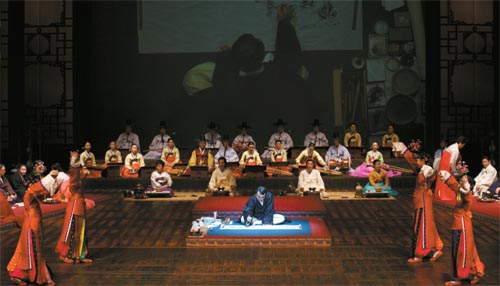Theater recreates centuries-old ceremony
Published: 13 Feb. 2011, 20:30

Calligrapher Ha Sang-ho writes a phrase to welcome the new spring season at the “Tea Party for the New Spring” celebration at the National Gugak Center in Seocho, southern Seoul, last Friday. Provided by National Gugak Center
Scholars of gugak, traditional Korean music, and arts experts on Friday recreated an annual celebration that had been held annually during the Joseon Dynasty (1392?1897) to celebrate the arrival of spring. Together, they performed music, drank tea, and ate at Yeak-dang, the main theater of the National Gugak Center, in Seocho, southern Seoul.
In the Joseon-era ceremonies, scholars were often invited as guests. The host would offer tea along with musical performances, dance and painting.
At the event on Friday, some guests dressed in hanbok, a traditional garment, and were seated on stage to feel apart of the performance. They were served tea. The rest of the audience observed the Joseon-era traditional Korean tea party.
Including Culture, Sports and Tourism Minister Choung Byoung-gug and the foremost gayageum player, Hwang Byungki, 16 guests were invited to sit on stage.
Seated center-stage were the National Gugak Center’s four performance groups, including Folk Music Group and Contemporary Gugak Orchestra, and other performers.
Attendees said the performances showed the charm of traditional Korean culture through tranquil and calm song and dance.
Royal dance performances chunangjeon and hyangbalmoo were played out onstage.
During the evening, calligrapher Ha Sang-ho wrote an auspicious phrase to welcome the spring, paleumgeukhae chuninhwarak, which means that eight elegant musical notes harmonize and offset evil; the sky, earth, and humans all become one and happiness and harmony would last for hundreds of thousands of years. The phrase was selected by the National Gugak Center, which also celebrated the 60th anniversary of its opening.
Followed by the calligraphy, painter Kim Chang-bae finished off a painting that featured red flowers and women, symbolizing spring’s spirit.
A giant screen set up behind the seated performers showed close-up videos of Ha and Kim at work.
After the hour-long opening portion, the second part of the tea party was proceeded in the lobby of Yeak-dang.
Culture Minister Choung made a short speech in which he encouraged the traditional arts experts to continue their good work. He mentioned that more foreigners should be shown Korea’s valuable cultural assets.
Food and drinks were served in the lobby so people could savor the traditional elements of the tea party.
Sikhye, a non-alcoholic rice juice, makeolli, rice wine, and lotus flower tea were served with traditional snacks, such as caramel walnuts, ddeok, or rice cake, and yakbab, flavored glutinous rice mixed with honey, dates, chestnuts, and many other things.
This is the second time that the National Gugak Center has held this event.
By Lee Sun-min [summerlee@joongang.co.kr]










with the Korea JoongAng Daily
To write comments, please log in to one of the accounts.
Standards Board Policy (0/250자)